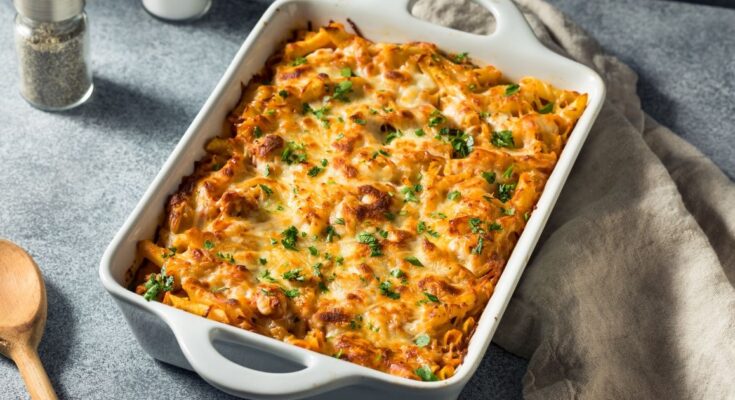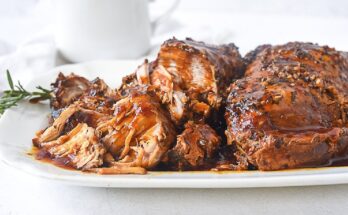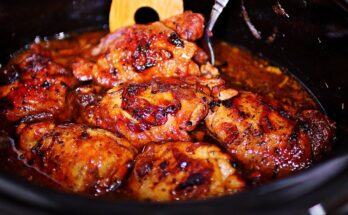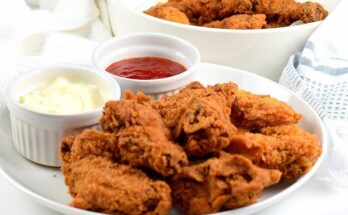Baked Mostaccioli Recipe: If you’re searching for the ultimate comfort food that’s cheesy, hearty, and packed with flavor, baked mostaccioli should be at the top of your list. This Italian-American dish is beloved for its rich layers of pasta, savory sauce, and gooey melted cheese that comes together in one delicious casserole. Think of it as the cousin of baked ziti or lasagna, but with its own unique twist.
In this guide, we’ll go step by step, from choosing the right ingredients to baking it perfectly. By the end, you’ll have all the tools to create a baked mostaccioli recipe that rivals your favorite Italian restaurant.
Ingredients You’ll Need
Like any great dish, baked mostaccioli starts with the right ingredients. The beauty of this recipe is that it doesn’t require anything fancy—most of the items you probably already have in your pantry or fridge. The combination of pasta, sauce, meat, and cheese is simple, but when baked together, it transforms into something extraordinary.
Here’s a breakdown of what you’ll need:
Core Ingredients:
- 1 pound mostaccioli pasta (or substitute penne if you can’t find it)
- 1 pound ground beef or Italian sausage (mild or spicy, depending on your preference)
- 1 medium onion, diced
- 3 cloves garlic, minced
- 1 jar (24 oz) of marinara or spaghetti sauce (or homemade if you prefer)
- 1 can (15 oz) crushed tomatoes
- 2 cups shredded mozzarella cheese
- 1 cup ricotta or cottage cheese (optional but adds creaminess)
- ½ cup grated Parmesan cheese
- 2 tablespoons olive oil
- Salt and pepper to taste
- 1 teaspoon Italian seasoning (oregano, basil, thyme mix)
Optional Add-Ons for Extra Flavor:
- Red pepper flakes for a spicy kick
- Fresh basil or parsley for garnish
- Sautéed mushrooms, bell peppers, or spinach for extra veggies
- A touch of cream or mascarpone for a richer sauce
When choosing your ingredients, quality makes all the difference. A good marinara sauce and fresh mozzarella can take this dish from good to unforgettable. Likewise, choosing between beef and sausage changes the overall flavor—sausage tends to give it a deeper, more robust taste, while beef keeps it classic and mild.
Once you’ve gathered everything, you’re ready to move on to the fun part: cooking!
Step-by-Step Guide
Now that you’ve got your ingredients lined up, let’s break down the cooking process into easy, manageable steps. Baked mostaccioli is essentially about layering flavors—cooking pasta, preparing the sauce, and baking everything together until it’s golden and bubbling.
Step 1: Preparing the Pasta
Bring a large pot of salted water to a boil. Add the mostaccioli and cook it about 2 minutes less than the package instructions—remember, it will continue cooking in the oven. Drain the pasta and drizzle with a little olive oil to prevent sticking.
Step 2: Making the Meat Sauce
In a large skillet, heat olive oil and sauté the onion until softened. Add garlic and cook for another minute. Stir in ground beef or sausage, breaking it apart with a spoon until browned and fully cooked. Drain excess fat if needed. Add marinara sauce and crushed tomatoes, then season with Italian herbs, salt, and pepper. Simmer for about 10 minutes so the flavors meld together.
Step 3: Mixing Pasta and Sauce
In a large mixing bowl, combine the pasta with half of the sauce. This ensures that every piece of pasta is coated with flavor. Reserve the other half of the sauce for layering.
Step 4: Assembling the Casserole
Preheat your oven to 375°F (190°C). In a greased baking dish, spread a thin layer of sauce on the bottom. Add half of the pasta mixture, then spread dollops of ricotta or cottage cheese. Sprinkle with mozzarella and Parmesan. Add the remaining pasta and top with the rest of the sauce. Finish with a generous layer of mozzarella and Parmesan.
Step 5: Baking to Perfection
Cover the dish with foil and bake for 25 minutes. Remove the foil and bake for another 15-20 minutes, or until the cheese is melted, bubbly, and slightly golden. Let it rest for 5 minutes before serving.
The result? A cheesy, saucy, hearty casserole that will have everyone going back for seconds.
Variations of Baked Mostaccioli
One of the reasons baked mostaccioli has stood the test of time is its adaptability. You can tweak the ingredients to suit different tastes, diets, or even what you have on hand. Here are some delicious variations to try:
Vegetarian Baked Mostaccioli
Skip the meat and bulk up the sauce with sautéed vegetables like zucchini, mushrooms, bell peppers, or spinach. Add extra herbs for a burst of freshness. This version is just as hearty and satisfying.
Spicy Sausage Mostaccioli
If you love bold flavors, swap ground beef for spicy Italian sausage. You can even add red pepper flakes to the sauce for an extra kick. This version pairs beautifully with a side of garlic bread.
Creamy Alfredo Mostaccioli
For something indulgent, replace marinara with a creamy Alfredo sauce. Layer it with chicken, broccoli, and mozzarella for a comforting twist that’s rich and decadent.
The beauty of baked mostaccioli lies in its versatility—there’s no wrong way to make it. Whether you stick to the traditional recipe or experiment with new flavors, the result is always delicious.
Tips and Tricks for the Perfect Baked Mostaccioli
Even though baked mostaccioli is straightforward, a few insider tips can take your dish from good to outstanding.
1. Don’t Overcook the Pasta
Since the pasta bakes in the oven, it’s important to cook it slightly under al dente. This prevents it from turning mushy after baking.
2. Layer the Cheese Generously
Cheese is the star of this dish, so don’t be shy. A mix of mozzarella for meltiness and Parmesan for sharpness creates the perfect balance. Adding ricotta or cottage cheese makes it creamy and luxurious.
3. Let it Rest Before Serving
It’s tempting to dive right in, but giving the casserole 5–10 minutes to rest helps the layers set, making it easier to serve without falling apart.
4. Make it Ahead of Time
You can prepare baked mostaccioli in advance, refrigerate it, and bake it the next day. It’s perfect for meal prep or feeding a crowd.
5. Storing and Reheating Leftovers
Store leftovers in an airtight container in the fridge for up to 4 days. To reheat, cover with foil and bake at 350°F (175°C) until warmed through. You can also freeze baked mostaccioli for up to 2 months.
These little adjustments make a big difference, ensuring your baked mostaccioli always comes out restaurant-quality.
Serving Suggestions for Baked Mostaccioli
Baked mostaccioli is already a filling, satisfying dish on its own, but the right sides can turn your meal into a complete dining experience. Since it’s rich, cheesy, and saucy, pairing it with lighter, fresher accompaniments balances everything out beautifully.
One of the most classic pairings is garlic bread. Imagine dipping warm, buttery, garlicky bread into that leftover sauce on your plate—it’s a match made in heaven. You can go with traditional Italian bread slices, Texas toast, or even homemade garlic knots.
Another must-have side is a fresh salad. A simple Caesar salad with crisp romaine, Parmesan, and crunchy croutons adds freshness and texture. Or, go for a garden salad with tomatoes, cucumbers, red onions, and a tangy vinaigrette to balance the richness of the pasta.
If you want to elevate your dinner, add roasted vegetables like zucchini, asparagus, or broccoli. The caramelized flavors from roasting add depth and give you a nice contrast to the creamy, cheesy casserole.
Don’t forget beverages. For a family-friendly option, sparkling water with lemon or a chilled iced tea pairs well. If you’re going for a more sophisticated vibe, a glass of red wine like Chianti or Cabernet Sauvignon complements the tomato-based sauce perfectly.
Lastly, if you’re planning a dinner party, round out the meal with a light dessert. Something like lemon sorbet, panna cotta, or even fresh fruit works well since it won’t feel too heavy after a rich pasta dish.
With these pairings, baked mostaccioli transforms from a simple comfort meal into a full Italian-inspired dining experience.
Why Baked Mostaccioli is Perfect for Gatherings
There are certain dishes that just feel right for sharing, and baked mostaccioli is one of them. Its casserole-style presentation makes it ideal for feeding a group, whether it’s a holiday gathering, potluck, or Sunday family dinner.
First, it’s budget-friendly. Mostaccioli pasta, sauce, cheese, and meat are all affordable ingredients that can stretch to feed a large crowd. You can easily double the recipe in a large baking dish if you’re hosting more guests.
Second, it’s easy to prepare ahead of time. You can assemble the casserole in the morning, pop it in the fridge, and then just bake it before serving. That way, you’re not stuck in the kitchen when guests arrive.
Third, it’s a crowd-pleaser. Everyone loves pasta and cheese, and baked mostaccioli hits all the right notes—savory, cheesy, hearty, and comforting. Even picky eaters will dig in without hesitation.
Another reason it’s perfect for gatherings is its versatility. You can make multiple versions—one with sausage, one vegetarian, one spicy—and please everyone without too much extra effort. It’s also easy to transport if you’re taking it to a potluck.
Lastly, the dish has a beautiful presentation. When you pull it out of the oven, bubbling with melted cheese and golden on top, it looks irresistible. Add a sprinkle of fresh basil or parsley, and it’s centerpiece-worthy.
For these reasons, baked mostaccioli isn’t just a meal—it’s a dish that brings people together, makes hosting stress-free, and leaves everyone asking for seconds.
Healthier Alternatives for Baked Mostaccioli
While baked mostaccioli is undeniably delicious, it’s also quite indulgent with all that cheese and pasta. The good news? You can make a few smart swaps to enjoy a lighter, healthier version without losing the comfort factor.
1. Use Whole Wheat or Gluten-Free Pasta
Switching to whole wheat pasta boosts fiber and nutrients, making it more filling. If you’re gluten-sensitive, go for gluten-free options like brown rice or chickpea pasta.
2. Swap Out the Meat
Instead of beef or sausage, use ground turkey or chicken. They’re leaner but still give you that meaty texture. For a completely plant-based option, try lentils, mushrooms, or a meat substitute like Beyond Meat.
3. Choose a Lighter Cheese Blend
Cheese is the star, but you can be strategic. Use part-skim mozzarella and low-fat ricotta to cut down on calories. A little Parmesan goes a long way for flavor, so you don’t need as much.
4. Bulk Up with Vegetables
Adding zucchini, spinach, eggplant, or bell peppers not only stretches the dish but also makes it more nutrient-dense. Roasted veggies add a smoky sweetness that blends perfectly with the sauce.
5. Watch the Sauce
Many jarred pasta sauces are loaded with sugar and sodium. Either make your own from fresh tomatoes or choose a low-sodium version with no added sugar.
6. Portion Control
Even with lighter ingredients, pasta can be heavy if you overdo it. Pair your serving with a side salad so you can enjoy a smaller portion without feeling deprived.
By making these swaps, you can still enjoy baked mostaccioli guilt-free. It’s proof that comfort food can be both delicious and balanced.
The History and Origin of Mostaccioli
Like many Italian-American favorites, baked mostaccioli has roots in traditional Italian cooking but took on its own identity in the U.S. The word “mostaccioli” comes from the Italian word mostaccio, meaning “mustache,” referring to the pasta’s shape. In Italy, however, you won’t commonly find baked mostaccioli—it’s more of an Italian-American creation.
The pasta itself is similar to penne, but in Italy, penne rigate (with ridges) is more popular, while mostaccioli lisce (smooth) is less common. When Italian immigrants came to the U.S., they adapted recipes based on what ingredients were available. Pasta casseroles became especially popular because they were affordable, filling, and perfect for feeding large families.
In Italian-American communities, particularly in Chicago and St. Louis, baked mostaccioli became a staple at weddings, church events, and Sunday dinners. It was often served alongside other hearty dishes like fried chicken, Italian sausage, and meatballs.
Today, baked mostaccioli is considered comfort food at its finest. It carries with it the history of immigrant families who made the most of what they had, creating dishes that were both practical and delicious. It’s more than just pasta—it’s a story of tradition, adaptation, and the enduring love of family meals.
Pairing Baked Mostaccioli with Wines
If you’re a wine lover, baked mostaccioli offers the perfect excuse to pour a glass. The hearty combination of pasta, tomato sauce, meat, and cheese pairs beautifully with different types of wine, enhancing both the flavors of the dish and the wine itself.
Red Wines: Tomato-based pasta dishes almost always shine with red wine, especially those with medium acidity to balance the tang of the sauce. Chianti, Sangiovese, and Barbera are Italian classics that pair naturally. If you prefer something bolder, Cabernet Sauvignon or Merlot works well, especially with sausage-based mostaccioli.
White Wines: Though less traditional, certain white wines can be a refreshing pairing. A crisp Pinot Grigio or Sauvignon Blanc cuts through the richness of the cheese and brings out lighter herbal notes in the sauce. Chardonnay, especially unoaked, is also a nice choice for creamy versions like Alfredo mostaccioli.
Sparkling Wines: If you’re celebrating, don’t overlook a glass of Prosecco or Champagne. The bubbles add a playful contrast to the rich and cheesy texture, making every bite feel lighter.
Non-Alcoholic Options: For those skipping alcohol, sparkling water with lemon, Italian soda, or a chilled iced tea pairs wonderfully. Grape juice or cranberry juice also mimic the fruity notes of wine without the alcohol.
The key is balance: the wine should complement, not overpower, the baked mostaccioli. Choosing the right pairing elevates the dish from casual comfort food to a restaurant-quality experience at home.
Making Baked Mostaccioli Ahead of Time
One of the biggest advantages of baked mostaccioli is that it’s a fantastic make-ahead dish. Whether you’re meal-prepping for the week or preparing for a big family dinner, this pasta casserole holds up beautifully in the fridge or freezer.
Assemble and Refrigerate: You can prepare the entire dish—cook the pasta, make the sauce, layer everything in the baking dish—then cover it tightly with foil and refrigerate for up to 24 hours. When you’re ready to bake, just pop it in the oven. You may need to add 10–15 minutes to the baking time since it will be cold.
Assemble and Freeze: For longer storage, baked mostaccioli freezes very well. Assemble the casserole in a freezer-safe dish, cover tightly with foil, and freeze for up to 2 months. When you’re ready, thaw it overnight in the fridge, then bake as usual.
Freezing Leftovers: If you’ve already baked it, you can freeze individual portions in airtight containers. This makes reheating easy—just pop one serving in the oven or microwave whenever you’re craving comfort food.
Pro Tip: If you know you’ll be freezing it, slightly undercook the pasta so it doesn’t get mushy when reheated. Also, add a little extra sauce to keep it from drying out.
With these make-ahead methods, baked mostaccioli becomes a lifesaver for busy families and entertainers alike. It’s the perfect “cook once, eat twice” kind of dish.
Common Mistakes to Avoid When Making Baked Mostaccioli
Even though baked mostaccioli is simple to make, there are a few pitfalls that can affect the final result. Here’s what to watch out for:
1. Overcooking the Pasta
This is the most common mistake. If you cook the pasta fully before baking, it will turn mushy. Always cook it 1–2 minutes less than package directions.
2. Skipping the Seasoning
Don’t rely solely on jarred sauce. Always taste your sauce and adjust with salt, pepper, and herbs. A bland sauce will make the entire dish fall flat.
3. Not Using Enough Sauce
If your pasta isn’t well-coated, the casserole will turn out dry. Be generous with the sauce, especially when layering.
4. Using Only One Cheese
Mozzarella is great for melting, but it can be bland on its own. Combining it with Parmesan or ricotta adds depth of flavor and creaminess.
5. Baking Without Covering First
If you skip covering the dish with foil, the cheese can burn before the inside heats through. Always cover for the first part of baking, then uncover to brown the top.
6. Cutting Into It Too Soon
Patience is key. If you scoop it out right after baking, it can fall apart. Letting it rest for at least 5 minutes helps the layers hold together.
Avoid these mistakes, and you’ll have a perfectly baked, cheesy, flavorful mostaccioli every time.
Storing and Reheating Leftovers
Baked mostaccioli makes excellent leftovers, and if stored properly, it tastes just as good (if not better) the next day.
Storing in the Refrigerator: Allow the casserole to cool completely before storing. Transfer it into an airtight container or cover the baking dish tightly with foil. It will last up to 4 days in the fridge.
Reheating in the Oven: For best results, reheat in the oven. Cover with foil and bake at 350°F (175°C) for about 20–25 minutes, or until heated through. This keeps the pasta from drying out and the cheese melty.
Reheating in the Microwave: If you’re short on time, you can microwave individual portions. Place the pasta in a microwave-safe dish, cover with a damp paper towel, and heat in 1-minute intervals until warm.
Freezing Leftovers: You can freeze leftover baked mostaccioli for up to 2 months. Portioning it into freezer-safe containers makes reheating convenient. To reheat, thaw overnight in the fridge and bake as usual.
Pro tip: Add a spoonful of extra marinara sauce before reheating to keep it moist and flavorful.
With these storage methods, you’ll always have a quick, comforting meal ready to go.
Baked Mostaccioli vs. Baked Ziti: What’s the Difference?
At first glance, baked mostaccioli and baked ziti might look like the same dish. Both are cheesy pasta casseroles layered with sauce and baked until golden. But if you look closer, there are some subtle differences that set them apart.
The Pasta Shape: The biggest distinction is the pasta. Mostaccioli is smooth, tube-shaped pasta (lisce), while ziti is slightly longer and can have ridges. These ridges in ziti help trap sauce more easily, while mostaccioli offers a cleaner, creamier bite since the sauce clings differently.
Regional Popularity: Baked ziti is more common in Italian-American households on the East Coast, especially in New York and New Jersey. Baked mostaccioli, on the other hand, is more popular in the Midwest, particularly Chicago and St. Louis, where it’s a staple at weddings, church gatherings, and family events.
Cheese and Sauce Choices: Traditionally, baked ziti often includes ricotta cheese layered between the pasta and sauce, giving it a creamier texture. Baked mostaccioli usually relies more on mozzarella and Parmesan, although many modern recipes incorporate ricotta as well.
Taste and Texture: Both dishes are rich, saucy, and comforting, but baked ziti tends to feel denser because of the ricotta layers. Baked mostaccioli, with its smoother pasta, feels a little lighter and silkier in texture.
At the end of the day, the two are more cousins than twins—similar enough to satisfy the same craving but distinct enough to have their own place in the Italian-American kitchen.
How to Make Baked Mostaccioli for a Crowd
If you’re cooking for a big gathering, baked mostaccioli is one of the easiest and most cost-effective dishes to prepare. Here’s how to scale it up without stress.
1. Use Large Disposable Trays:
Instead of multiple casserole dishes, use large aluminum trays. They’re easy to transport, bake evenly, and make cleanup a breeze.
2. Double or Triple the Recipe: For every 12–15 people, one standard recipe (1 pound of pasta) should be doubled. For a wedding-style buffet of 50+ people, tripling or quadrupling is common.
3. Layer Strategically: When making larger portions, layering becomes even more important. Make sure every scoop has sauce, cheese, and pasta by alternating carefully.
4. Keep It Warm: For events, baked mostaccioli is often kept in chafing dishes with warming trays. This prevents it from drying out while guests serve themselves.
5. Offer Variety: If serving a crowd, make at least two versions—classic meat and vegetarian. That way, everyone has an option.
By preparing baked mostaccioli in bulk, you’ll have a hearty, crowd-pleasing dish that makes hosting stress-free.
FAQs about Baked Mostaccioli Recipe
1. Can I make baked mostaccioli without meat?
Yes! Simply skip the beef or sausage and load up on vegetables like mushrooms, zucchini, or spinach. You’ll still have a hearty, flavorful dish.
2. What’s the best cheese for baked mostaccioli?
Mozzarella is essential for meltiness, Parmesan adds sharpness, and ricotta or cottage cheese adds creaminess. A blend of these gives the best flavor.
3. Can I use penne instead of mostaccioli?
Absolutely. Penne is the closest substitute, especially penne lisce (smooth). Penne rigate (ridged) works too and holds onto sauce even better.
4. How do I prevent baked mostaccioli from drying out?
Be generous with sauce, cover the dish with foil during the first half of baking, and don’t overcook the pasta before baking.
5. Is baked mostaccioli freezer-friendly?
Yes! You can freeze it before or after baking. Just wrap tightly and store for up to 2 months. Thaw overnight in the fridge before reheating.
Conclusion
What makes it truly special is its versatility. You can keep it classic with beef and marinara, go spicy with sausage, make it vegetarian with fresh veggies, or even turn it creamy with Alfredo. Whether you’re serving a small family dinner or preparing trays for a large celebration, baked mostaccioli adapts beautifully.
From learning the history of the dish to mastering storage tips and variations, you now have everything you need to create a perfect baked mostaccioli at home. So, gather your ingredients, preheat the oven, and get ready for a cheesy, comforting masterpiece that will have everyone asking for seconds.



